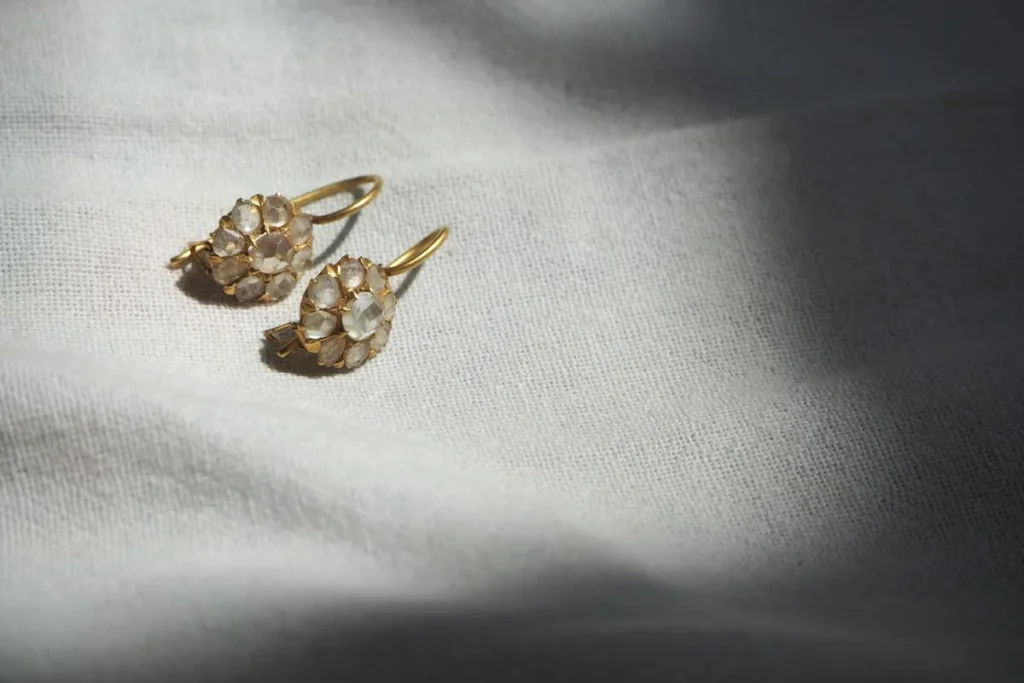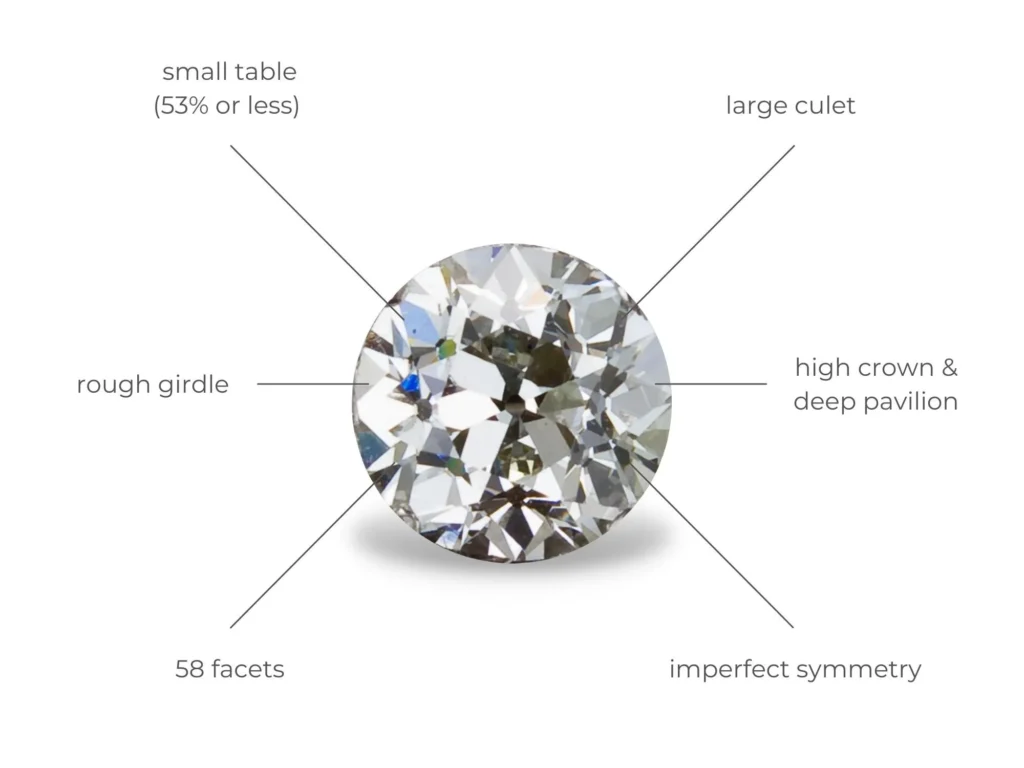Introduction

The Old European Cut diamond, also known as the Old Euro Cut or Old European Cut, is a classic diamond cut that originated in the 19th and early 20th centuries.
It was the successor to the Rose Cut and Old Mine Cut styles and marked a significant advancement in diamond-cutting technology.
It gained popularity during the Victorian and Edwardian eras, particularly for engagement rings and fine jewelry.
In the early 20th century, diamond-cutting techniques continued to evolve, leading to the development of more modern cuts like the Round Brilliant Cut.
The Old European Cut gradually fell out of favor, but it remains a sought-after gem for its unique charm, distinct appearance, and historical significance.
Understanding the Old European Cut is valuable for collectors, enthusiasts of vintage and antique jewelry, and personal collectors.
This guide provides a comprehensive exploration of Old European Cut diamonds, including their history, characteristics, brilliance and fire, evaluation and grading, collector’s insights, maintenance and care, and buying considerations.
What is an old European cut Diamond?
Old European-cut diamonds, originating in the 19th century, were a popular vintage cut until the early 20th century.
They are characterized by their unique faceting and appearance, making them highly sought after by collectors and those who appreciate vintage and antique jewelry.
Some key features of Old European Cut Diamond
Round Shape: OEC diamonds are typically round in shape, although slight deviations such as oval or cushion-like appearances can occur.
Specific Faceting Pattern: OEC diamonds have a unique facet pattern with fewer, larger facets. They typically feature 58 facets, combining step-cut and brilliant-cut facets.

Play-of-Color: OEC diamonds are known for their distinctive play of colorful sparkle. They produce larger, broader flashes of light, creating a charming, vintage aesthetic.
Open Culet: Many OEC diamonds have an open culet, where the pointed tip at the bottom of the diamond is visible, unlike modern diamonds with closed culets.
Higher Crown: OEC diamonds have a higher crown, creating a larger and more pronounced diamond “belly” or “cushion” in the center of the stone.
Old European Cut (OEC) diamonds have a distinct faceting pattern with fewer, larger facets, typically 58. They have a pointed culet, while modern round brilliant-cut diamonds have a more complex pattern with 57 or 58 facets.
OEC diamonds produce larger flashes of colorful sparkle, while modern round brilliant-cut diamonds have intense, consistent sparkle. OEC diamonds may exhibit variations in symmetry due to hand-cutting techniques, while modern diamonds are precision-cut to strict standards.
Characteristics of Old European Cut Diamonds
- OEC diamonds are known for their distinctive features, shape, and facet arrangement, resulting in a “chunky” appearance.
- They typically have a round shape, although slight variations in outline may occur due to hand-cutting techniques.
- OEC diamonds often feature a large culet, the facet at the diamond’s bottom, which is frequently open, creating a small hole in the pavilion.
- These diamonds have a higher crown, the part above the girdle, contributing to their unique appearance.
- The facet arrangement in OEC diamonds is larger, broader, and fewer compared to modern round brilliant cut diamonds, giving them their distinctive “chunky” look.
- A smaller table facet further enhances the unique play of color in OEC diamonds.
- OEC diamonds are highly sought after for their romantic and antique charm, making them popular for vintage-inspired jewelry.
- To identify an OEC diamond, examine its shape, the presence of a large culet, facet arrangement, higher crown, play-of-color, vintage setting, certification, and documentation, and seek an expert opinion.
Pros and Cons of Old European Cut Diamonds
Pros :
- Antique Charm: Old European Cut diamonds exude vintage and antique charm, making them appealing to those who appreciate historical jewelry.
- Unique Appearance: They have a special appearance with a cushion or square shape, significant facets, and a small table. This gives them a distinct, romantic, and chunky look.
- Warm and Subtle Brilliance: Old mine cuts offer a warmer and more subdued brilliance compared to modern cuts. Their play-of-color is often softer and more colorful.
- Collector’s Value: Due to their rarity and historical significance, old mine-cut diamonds are highly sought after by collectors and enthusiasts.
- Customization: Old mine cut diamonds can be custom-set in vintage or vintage-inspired jewelry, allowing for a personalized and one-of-a-kind piece.
Cons :
- OEC diamonds may require more careful maintenance due to their older cut style and potential for wear over time.
- OEC diamonds tend to have lower brilliance and sparkle compared to modern round brilliant cuts.
Old European vs. Modern Brilliant
Some factors encompass the characteristics of the diamond and the overall experience it offers. Here are the key considerations:
- Fire vs. Sparkle: Old mine cut diamonds are known for their vibrant “fire” play-of-color and softer, romantic sparkle, compared to modern brilliant cuts.
- Hand-Crafted vs. Machine-Cut: Old mine cut diamonds, traditionally hand-cut by skilled artisans, have a vintage charm, while modern diamonds are machine-cut for precision, resulting in variations in facet size and appearance.
- Antique vs. Classic Appeal: Old mine cut diamonds, dating back to the 18th and 19th centuries, offer an authentic antique aesthetic and timeless elegance, making them ideal for vintage and historical jewelry styles.
- Rare vs. Readily Available: Old mine cut diamonds are rare and sought after by collectors, but they are not as readily available as modern brilliant cuts and may come at a premium.
Evaluating Old European Cut Diamonds
- Diamond grading reports are crucial tools for assessing the qualities of a diamond, including color, clarity, and carat weight. They provide a standardized way to communicate a diamond’s characteristics, helping buyers make informed decisions.
- Color is graded on a scale from D (colorless) to Z (light yellow or brown), with the absence of color being prized.
- Clarity is graded on a scale from Flawless to Included, with each grade having specific criteria for the type, size, and location of inclusions and blemishes.
How to Shop for Old European Cut Diamonds
To make an informed purchase of a diamond, consider the Four Cs: cut, color, clarity, and carat weight. The Gemological Institute of America (GIA) is a reputable organization that verifies a diamond’s authenticity and provides information on the Four Cs.
Other reputable gemological laboratories include AGS (American Gem Society), IGI (International Gemological Institute), and HRD (Hoge Raad voor Diamant). Request additional documentation to verify the diamond’s provenance, quality, and value.
Determine your budget and prioritize what matters most to you. Choose a diamond shape and setting that suits your style and preferences.
Purchase from reputable jewelers or dealers. Consider your lifestyle and wearability to ensure the diamond’s durability. Select a diamond that speaks to you and aligns with your style.
Familiarize yourself with the vendor’s return and warranty policies. A combination of these factors ensures a well-informed decision and a diamond that meets your expectations and value.
Care and Maintenance of Old European Cut Diamonds
- Old European Cut (OEC) diamonds require special care to preserve their unique charm and value.
- To clean and store OEC diamonds, use gentle cleaning methods such as soaking them in warm soapy water for 20–30 minutes, using a soft brush, rinsing thoroughly, and patting them dry with a soft cloth.
- Ultrasonic cleaners may be suitable for some diamonds, but consult a jeweler or the diamond’s certification for guidance.
- Professional cleaning is recommended by a reputable jeweler to inspect the diamond for loose settings or potential issues.
- Store OEC diamonds separately from other jewelry to prevent scratches and damage. Keep away from heat, harmful chemicals, and extreme temperatures to prevent damage.
- Regularly inspect the diamond and its setting for signs of wear or loose prongs, and promptly address any issues by visiting a jeweler for maintenance or repairs.
- Insurance is essential for protecting OEC diamonds against loss, theft, or damage. Have your OEC diamond professionally cleaned and inspected at least once a year.
- Avoid impact and rough handling, regular inspections, exposure to chemicals, secure settings, protective settings, extreme temperatures, and storage separately.
- Ensure your OEC diamond is adequately insured to protect against loss, theft, or accidental damage.
- Visit a reputable jeweler for professional maintenance and cleaning, and avoid ultrasonic cleaners. Store your OEC diamond jewelry in a secure and protected location when not wearing it.
- Follow proper cleaning techniques to remove dirt and oils that can affect the diamond’s brilliance and clarity.
- Maintaining the beauty of OEC diamonds over time involves a combination of regular care, professional maintenance, and protective measures.
Old European Cut Diamond Value
Several factors determine the value of an Old European Cut (OEC) diamond, including carat weight, cut quality, color grade, clarity grade, shape and proportions, age and historical significance, setting and design, market demand, certification and documentation, condition and maintenance, rarity of features, and provenance and history.
Larger OEC diamonds are more valuable, while well-cut diamonds with symmetrical facets and proper proportions command higher prices.
Colorless or near-colorless diamonds are more valuable, while clarity grades indicate the presence of inclusions and blemishes.
The setting and design of the jewelry piece also impact the value, with intricate vintage or antique settings adding to the overall worth.
Conclusion
The unique qualities of Old European Cut (OEC) diamonds include their vintage elegance, distinctive faceting, historical significance, romantic appeal, handcrafted beauty, sustainability, and personal connection.
It highlights the historical significance of OEC diamonds, their romantic appeal, and their repurposing for ethical and eco-friendly jewelry.
The Old European Cut (OEC) diamond’s round shape, historical significance, and unique character make it a popular choice for classic, vintage, and romantic styles, as well as larger flashes of light.
FAQ’S
The age of the diamond, if known, is a reasonable way of verifying that it is not a blood diamond. Examples of ethical diamonds would be any genuine old mine or old European cuts.
An old European–cut diamond has a round shape featuring 58 large facets and a small circle in the center
According to the Gemological Institute of America (GIA), an old European cut diamond should have a table less than or equal to 53% of its total diameter
Old mine-cut stones have that beautiful cushion-like shape, while Old Europeans have a traditional round shape.
